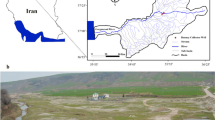Abstract
The Kuihe River is in Xuzhou, Jiangsu, China. It contains high concentrations of nitrogen. The water in the Kuihe River recharges the groundwater via riverbank filtration (RBF) along the Xucun and Huangqiao reaches, which are characterized by unsaturated and saturated percolations, respectively. The two sections were selected to study the effectiveness of RBF to the nitrogen removal from the infiltrating river water. The results showed that the RBF in the saturated percolation had the potential to remove the nitrogen through biochemical processes. The nitrogen-removal rates were more than 95% over the monitoring period. However, the RBF in the unsaturated percolation resulted mainly from the physical process and thus had no efficacy for nitrogen removal.


Similar content being viewed by others
References
Bear J (1988) Dynamics of fluids in porous media. Courier Dover Pub, New York, pp 43–224
Doussan C, Guillemette P, Emmanuel L, Michel D (1997) River-bank filtration: modeling of the changes in water chemistry with emphasis on nitrogen species. J Contam Hydrol 25(1–2):129–155
Gunten UV, Zoberist J (1993) Biogeochemical changes in groundwater infiltration system: column studies. Geochim Cosmochim Acta 57:3895–3906
Han W, He K (2004) Study on the biodegradability of wastewater from the Kuihe river. Environ Technol 22(3):42–45
Hiscock KM, Grischek T (2002) Attenuation of groundwater pollution by bank filtration. J Hydrol 266:139–144
Jiang C, Xia Z, Liu L (1997) Variation trends of three types of nitrogen in the soil and groundwater after wastewater irrigation. Adv Water Sci 8(2):183–188
Jütter F (1999) Efficacy of bank filtration for the removal of fragrance compounds and aromatic hydrocarbons. Water Sci Technol 40(6):123–128
Kayabalı K, Celik M, Karatosun H, Arıgün Z, Koçbay A (1999) The influence of a heavily polluted urban river on the adjacent aquifer systems. Environ Geol 38(3):233–243
Li JU (2001) Brief discussion of protection of water environment and water resource utilization of Kuihe river. Jiangsu Environ Sci Technol 14(3):28–29
Li W, Wei Y (1998) Investigation of influence of the Kui River pollution on resident potable water source. Anhui J Prev Med 4(1):1–4
Maier RM, Pepper IL, Gerba CP (2000) Environmental microbiology. Academic, A Harcourt Science and Technology Company, San Diego, p 43
Ministry of Construction of the People’s Republic of China (1996) National Standards. Integrated wastewater discharge standard, China, GB8978-1996
Ministry of Health of the People’s Republic of China (1985) State sanitary standard for drinking water, China, GB5749-85
Ray C, Grischek T, Schubert J (2002) A perspective of riverbank filtration. J Am Water Works Assoc 94(4):149–162
Schwarzenbach RP, Giger W (1985) Behavior and fate of halogenated hydrocarbons in groundwater. In: Ward DH (ed) Groundwater quality. Wiley, New York, pp 446–471
Schwarzenbach RP, Westall J (1981) Transport of nonpolar organic compounds from surface water to groundwater: laboratory sorption studies. Environ Sci Technol 15:1360–1367
State Environmental Protection Administration of China (1998) Monitor methods for water and wastewater. China Press House of Environmental Science, Beijing, pp 179–500
Tufenkji N, Ryan JN, Elimelech M (2002) The promise of bank filtration. Environ Sci Technol 11:422A–428A
Wang CH, Li Y, Bao ZH (2002) Experimental research of the influence of polluted river on its offshore groundwater environment. J Hydrodyn 17(1):17–24
Weiss WJ, Bouwer EJ, Aboytes R (2005) Riverbank filtration for control of microorganisms: results from field monitoring. Water Res 39:1990–2001
Zhu ZH (1990) Nitrogen in soil of China. Jiangsu Press of Science and Technology, Nanjing, pp 87–142
Acknowledgments
This paper was financially supported by the National Natural Science Foundation of China (No. 40472127).
Author information
Authors and Affiliations
Corresponding author
Rights and permissions
About this article
Cite this article
Wu, Y., Hui, L., Wang, H. et al. Effectiveness of riverbank filtration for removal of nitrogen from heavily polluted rivers: a case study of Kuihe River, Xuzhou, Jiangsu, China. Environ Geol 52, 19–25 (2007). https://doi.org/10.1007/s00254-006-0445-4
Received:
Accepted:
Published:
Issue Date:
DOI: https://doi.org/10.1007/s00254-006-0445-4




